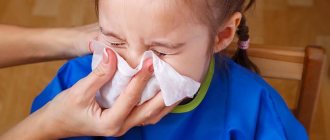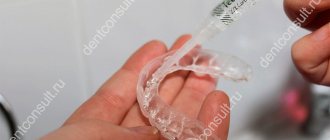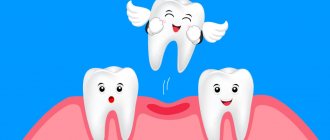How to Reduce Teething Pain
Fever and pain can be reduced by:
- massage the gums where tooth eruption is expected;
- the gums can be lubricated with an anesthetic;
- give the child a vasoconstrictor if the child has a runny nose;
- if the temperature rises above +38C, then the child should be given an antipyretic in the form of a sweet syrup.
Usually, the eruption of baby teeth occurs without complications. In some cases, a complication may occur that is caused by:
- Presence of a dental cyst.
- When the baby tooth has not yet come out, but it is supported by a permanent tooth.
- When a fang erupts, it is out of place in the dentition.
What teeth are called eye teeth?
Eyeteeth is a folk term, not a medical one. In common parlance, this is usually what the upper canines are called, and by analogy with them, the lower ones too.
Probably, the fangs received their special name due to the fact that next to them there are branches of the facial nerve, when irritated, severe pain occurs, spreading to the upper half of the face and radiating into the eyes. That is why, when a child develops baby eye teeth, it is accompanied by excruciating pain and other unpleasant symptoms. And because of this, removing fangs in adults is a very painful procedure that requires serious anesthesia.
Despite their name, eye teeth do not affect vision in any way. Although quite often dental patients express the opinion that if a fang is removed they can easily go blind, such a prejudice has no medical evidence and is erroneous.
Eye teeth in older children
Permanent eye teeth erupt in children aged 9-12 years. Normal eye tooth eruption should occur painlessly. If pain still bothers the child, it may be caused by:
- the presence of infection in the oral cavity;
- periodontal disease;
- development of dental caries.
The eye teeth may erupt in a crooked manner. Orthodontic treatment helps correct abnormal tooth growth. If a tooth erupts and grows incorrectly, it is removed on the advice of a dentist. After removing an eye tooth, it must be immediately replaced with a prosthetic so as not to disrupt the integrity of the dentition and not to impair the process of chewing food.
Features in adults
Although eye teeth tend to be more of a concern for young children, adults also often have questions related to some type of canine problem.
- At what age does the replacement of primary canines with permanent ones occur? Typically, the eye teeth on the upper jaw appear a little later than on the lower jaw. The approximate age when the lower canines grow is 9-10 years, and the upper ones are 11-12 years.
- How many permanent eye teeth appear and can they erupt before the front teeth? The canines appear fifth in the permanent dentition - after the first molars (5-6 years), central and lateral incisors (6-9 years), and first premolars (10-12 years). Violation of this pattern of eruption of permanent teeth can be both an individual characteristic of a person and a sign of serious dental pathology (for example, adentia due to the death of the rudiments of permanent teeth).
- Why can an eye tooth hurt? Normally, a healthy person should not have any pain in the teeth. If the eye tooth still hurts, then this may be a sign of a serious pathology: periostitis (flux), pulpitis, periodontitis and others. In any case, you should not engage in independent treatment - it is better to consult a dentist for qualified help. The only thing you can do before visiting the doctor is take a pain reliever.
- What to do if the eye tooth has grown incorrectly? Dental anomalies in the form of crooked teeth are quite common. In some, this defect is practically invisible, but sometimes the fangs erupt at a considerable distance from their intended place. This situation can be corrected by orthodontic treatment (braces, mouth guards), but sometimes, in especially severe cases, the doctor suggests pulling out a crooked tooth to straighten the dentition.
- Is it possible to remove eye teeth? Removing any tooth is an extreme measure that the dentist will only take as a last resort. And fangs are no exception to the rule. Premature loss of a baby eye tooth can lead to the formation of malocclusion, and its removal in an adult significantly impairs the chewing function of the teeth and also negatively affects a person’s appearance. But if you still had to pull out a fang, then you should have it prosthetically installed as early as possible.
While the eye teeth are special, the importance of the rest cannot be underestimated. It is necessary to carefully monitor the condition of the oral cavity - only this will help maintain a healthy and beautiful smile until old age.
How to reduce pain in an eye tooth using traditional medicine
Dental treatment of the eye tooth can be supplemented with treatment with traditional medicine. Typically, after visiting a dentist in a specialized clinic, they advise the following:
- Dissolve a teaspoon of baking soda or salt in a glass of warm water. Rinse your mouth with this solution several times a day.
- Prepare a decoction of medicinal herbs: chamomile, sage, or make an infusion of oak bark. Rinse your mouth with prepared decoctions and infusions several times a day.
The eruption of eye teeth in children should occur under the supervision of a pediatric dentist. Adults who have problems with their eye teeth should also see a dentist.
Prevention measures
It is important for mothers to remember that a child’s health begins in the womb.
After all, the baby’s teeth are formed during pregnancy. It has long been proven that the more the expectant mother takes care of her health during pregnancy, the stronger her child’s teeth will be. Doctors advise pregnant women to eat seafood, milk, kefir, and cheese. If a gynecologist advises you to buy a special vitamin complex containing calcium, you should not neglect this advice. A lack of calcium in a child’s body causes dental problems. Caring mothers go through life with the correct motto “a happy baby is a healthy baby.” This article is for informational purposes only, please consult your doctor for details! Ask your doctor about contraindications and side effects.
Notation systems
In dentistry, several systems for designating the dentition are practiced:
- universal (or alphanumeric);
- Viola;
- Zsigmondy-Plmersa;
- Haderupa.
All these systems have some differences, but are understandable to any dentist. The Viola system is considered the most convenient and used. This is what is recommended by the World Health Organization. Let's take a closer look at how each of them is deciphered.
Viola system
This system of designating the dentition has been used by dentists around the world since 1971 and is widely used among doctors today. Its peculiarity is that each element in the oral cavity is designated by a two-digit code, depending on its location in the oral cavity. The first number indicates the quadrant in which the tooth is located. Let's take a closer look at what is meant in dentistry by the word quadrant.
Visually, the human oral cavity can be divided into 4 parts. The right part of the upper jaw belongs to the 1st quadrant, the left – to the 2nd. The left part of the lower row is the 3rd quadrant, and the right – the fourth. The Viola system is also applicable to the preparation of dental formulas for milk elements. However, the quadrants have slightly different designations - 5, 6. 7, 8. The 5th quadrant corresponds in location to the 1st quadrant of the jaw in adults, 6 to the second quadrant, 7 to the 3rd quadrant, and 8 to the fourth. That is, the numbering starts from left to right for the upper jaw and from right to left for the lower jaw.
Designation of teeth according to the Viola system for permanent and primary teeth.
The second digit in the Viola system is the serial number of the element in the row. In this case, the countdown starts from the center of the dentition (for both jaws) and is deciphered as follows:
Can baby teeth hurt?
- 1 – central incisors;
- 2 – lateral incisors;
- 3 – fangs;
- 4–5 – premolars;
- 6, 7. 8 – molars.
The numbering of primary and permanent teeth according to the Viola system varies. Let's take a closer look at an example of how different teeth are designated. All elements from the first quadrant are called tens, so, for example, the upper central left incisor will have a numeric code - 11. All teeth in the first quadrant will have a 1 in the numeric code, and the last digit will change depending on the location in the row (the further away the tooth from the center, the larger the number). So, a wisdom tooth in the first quadrant will have a different numerical code - 18.
Elements located in the second quadrant are called twenties. The countdown also starts from the center of the jaw, from the left upper incisor (21). Thirties are located in the lower left corners of the jaw. The lower left incisor has the code 31. On the right side of the lower jaw, the first digit of the designation is 4. The second digit is indicated by analogy with the other quadrants.
Zsigmondy–Palmer formula
The formula was invented in 1876, but today it is used to designate the dentition due to convenience. Like the previous system, it is convenient to use for numbering elements in the oral cavity in both adults and children.
The theory is otherwise called square digital. According to it, all permanent elements are designated by numbers from 1 to 8, and dairy elements from I to V (Roman numerals). In most cases, this decoding is used by surgeons during maxillofacial operations and by orthodontists when correcting bite pathologies and installing fixed devices. Dentists and dentists rarely resort to the Zygmonti–Pamer designation because of its imperfections and the possibility of errors during the diagnosis and treatment of oral pathologies.
Haderup numbering
Based on the Zygmonti–Palmer theory. The peculiarities of the system are that the elements of the upper jaw are designated by a “+” sign, and the lower ones by “-”, while the elements themselves are numbered from 1 to 8.
Harpurd's theory for primary and mixed dentition.
For children, the designations change somewhat in that a zero is placed in front of the number.
Universal dental formula
Invented by the American Association of Medical Practitioners and includes letter and numerical designations for various elements of the dentition, depending on their structure and location. The peculiarity of the system is that each element is designated by a letter (by name) and a number (by location). The lateral and central incisors are abbreviated I, the premolars are P, the canines are C, and the molars are M.
Universal alphanumeric table.
The main differences between baby teeth and permanent teeth
Unlike 28 permanent teeth, the primary dentition requires the presence of 20 units. At the same time, they have a number of characteristic features.
- Smaller in size compared to permanent teeth.
- White with a slightly blue tint (permanent units have a slightly yellowish tint).
- Less developed and slightly short roots compared to permanent teeth.
- The enamel of primary teeth is poorly formed - thinner.
- Milk units can be erased (permanent ones can too, but this is considered a pathology).
As the child grows, baby teeth fall out on their own - this is the norm. The permanent dentition units should not fall out on their own.
Names of teeth
When making a diagnosis, dentists and dentists use certain numbers and letters. Special designations indicate which tooth requires treatment.
Currently, there are several systems and methods for designating elements in the oral cavity. For example, dairy elements are designated by Roman numerals, and constants by Arabic numerals. There is also a universal notation system that is used to compile a dental formula for both children and adults. According to this formula, each type of element belonging to a particular group is named in capital letters, without indicating their number:
I – incisors; C – fangs; P – premolars; M – molars.
In children, all groups of teeth are designated in a similar way, only lowercase letters are used instead of capital letters. Numerical and alphabetic abbreviations facilitate the diagnosis process and allow doctors to accurately navigate when identifying teeth that need treatment.
Universal formula for baby and permanent teeth.
The above dental formula for an adult is relevant only if he has all 32 teeth formed.
When do babies get their first teeth?
Undoubtedly, the question at what age children begin to develop their first baby teeth is very important for all parents. It is a kind of measure of the “normality” of the baby and determining the degree of its development. The classic timing for the appearance of a milk bite is as follows:
| Age, month | |
| Lower central incisors | 6-8 |
| Upper central incisors | 7-9 |
| Lower lateral incisors | 7-9 |
| Upper lateral incisors | 8-10 |
| Lower first molars | 12-16 |
| Upper first molars | 13-17 |
| Lower canines | 15-20 |
| Upper canines | 16-20 |
| Lower second molars | 20-30 |
| Upper second molars | 21-30 |
Recently, cases have become more frequent when a baby’s first tooth is cut before the generally accepted period of an average of 4 months. Many cases of babies being born with an erupted tooth have been recorded. Modern pediatricians consider this normal and do not recommend that parents worry about this.
However, parents are much more worried about the late appearance of teeth. The first incisors can appear at 10 months, a year or even later. No one can say in advance how many months a child’s first tooth will erupt. If the baby is healthy, eats well and receives a preventive dose of vitamin D in the autumn-winter period, then late teeth are also an individual version of the norm. By the way, the time of teeth appearance does not affect the “painfulness” of the process. This is another myth that the later the teeth are, the harder it is for the child to bear it.
How long does it take for a baby to cut his first tooth?
From the very moment the baby’s gums swell, and with all his appearance he shows that his first teeth are about to appear, mothers begin to worry about the question, how long does it take for the very first tooth to appear? How long will the child be capricious, hungry and have difficulty sleeping?
Since the schedule for the appearance of baby teeth is individual, the time required for the appearance of one is also difficult to predict. The speed of teething can be affected by the child’s health status, lack of calcium and other factors.
Scheme of eruption of the first milk teeth in children
The timing of the eruption of baby teeth is indicated in the table above, and how they are located in the jaw is shown in the figure.
On average, by the age of one year, a child should have 4-6 milk teeth, ideally 8, however, modern pediatrics and dentistry do not consider it a pathology if a completely healthy child has deviations in one direction or another.
What should you pay attention to when teething?
The above symptoms of the onset of teething are characteristic of almost all infants. However, some children have additional symptoms that need to be taken seriously:
- Temperature increase;
- Formation in the mouth of small watery blisters with cloudy or clear liquid;
- Increased redness and inflammation of the gums;
- Inflamed oral mucosa, accompanied by the formation of slight erosion.
In a healthy baby, when teething, contrary to popular belief and the advice of “experienced” relatives, the temperature does not rise. If this happens, it means that the child’s body is simultaneously exposed to some kind of inflammatory disease.
Most often, the listed signs indicate the development of a viral form of stomatitis or ARVI, which is not surprising given the child’s desire to put everything in his mouth. Therefore, you need to show the child to the doctor. If the pediatrician does not detect signs of an acute viral infection, take your baby to a dentist so that he can determine what form of stomatitis your child has caught and prescribe adequate treatment. Unfortunately, pediatricians are most often incompetent in this situation.









